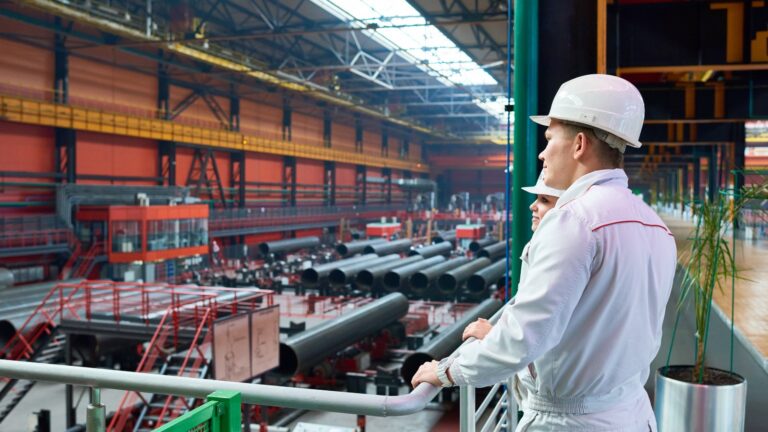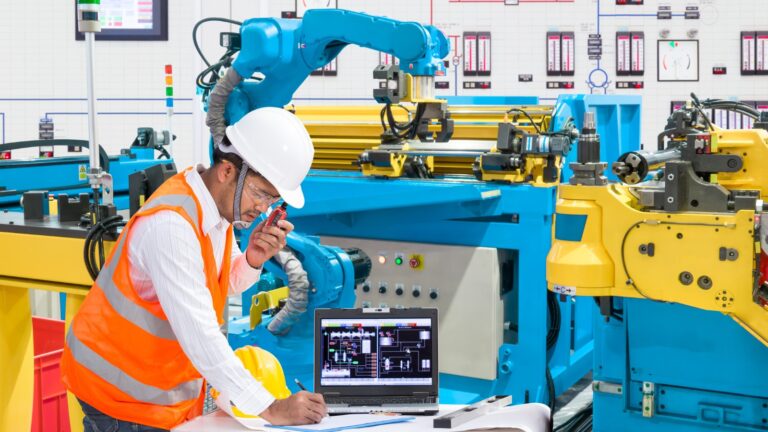When it comes to the manufacturing industry in Singapore, if you are planning to stay up with the ever-changing business landscape, you need to find novel solutions to streamline operations and generate profitability. Enter Enterprise Resource Planning or ERP technology, a disruptive solution that has emerged as a game changer for industrial cost-cutting initiatives. This combines several parts of corporate operations, such as inventory management, production planning, supplier coordination, and financial tracking.
It is a strong solution for businesses aiming to improve their bottom line while remaining flexible and competitive in the market, due to its ability to boost efficiency and decrease waste across the value chain. In this article, we will be exploring the depth of ERP in the manufacturing industry when cost saving is the main concern.
What is 'Enterprise Resource Planning'?

Before stepping into heavier information let us explain the true meaning of this. It refers to one of the world’s most popular technologies. It is a complete and integrated software solution meant to help organisations manage their fundamental business activities more efficiently. It consists of numerous modules that cover critical tasks like finance, human resources, supply chain management, production, inventory, and customer relationship management.
ERP systems provide a united, real-time database, allowing for seamless communication and cooperation across departments within a business. ERP boosts efficiency, decreases human mistakes, and enables data-driven decision-making by simplifying and automating procedures. This comprehensive technology enables companies to maximise resource usage, enhance operational efficiency, and obtain superior insights into overall performance, resulting in increased competitiveness and success in today’s business landscape.
How Can Manufacturers Save Money With ERP?

Energy Efficiency
As a world we are running out of energy, the priority should be given to saving the energies we are utilising. Energy efficiency is of the utmost importance in terms of how businesses save money using ERP. Manufacturers can more efficiently monitor energy use across their processes by employing ERP systems’ robust data monitoring and real-time analytics capabilities. This increased visibility enables them to identify regions of excessive energy use and adopt targeted optimisation techniques.
Predictive maintenance and automated operations also guarantee that equipment runs at optimal efficiency, lowering energy use. Also, it enables data-driven decision-making, allowing businesses to implement energy-efficient technology and practices that correspond with their financial objectives. This means that energy costs are significantly reduced, sustainability is improved, and the company gains a competitive advantage in the market, all thanks to the power of ERP technology.
Human Resource Management
When this industry is concerned, human labour is something we can not forget. This offers a unified platform for handling workforce data, including recruiting, employee performance, training, and payment. Manufacturers can reduce administrative procedures, decrease paperwork, and save time and effort for HR professionals by automating various HR activities. In addition, ERP allows for improved staff planning and scheduling, maximising worker utilisation and lowering overtime expenditures.
Manufacturers can pinpoint training requirements and invest in skill development with improved visibility into employee performance and skill sets, resulting in a more efficient and productive workforce. Finally, ERP’s integrated HRM features lead to cost savings, increased productivity, and greater employee satisfaction in manufacturing companies.
Streamlined Financial Management
ERP systems strengthen financial data, allowing for a real-time picture of the organisation’s financial health. It lowers human mistakes and speeds up financial operations by automating financial procedures like invoicing, accounts receivable, and accounts payable. Manufacturers can arrive at more informed decisions, optimise working capital, and negotiate better terms with suppliers with improved cash flow visibility and forecasting skills.
Plus, It enables accurate cost accounting, allowing companies to find cost-saving possibilities and efficiently manage resources. Manufacturers could identify areas for improvement, remove unnecessary expenditures, and eventually improve their financial performance and profitability through improved financial control and reporting.
Compliance and Regulatory Management
This simplifies the difficult task of complying with standard practices, safety standards, and legal obligations. Manufacturers can prevent costly fines, penalties, and legal issues by keeping correct records and automating compliance procedures.
Its extensive monitoring and reporting features help companies to show compliance during audits and inspections, saving time and money. Proactive monitoring and notifications in ERP systems can assist manufacturers in staying ahead of regulatory changes, guaranteeing timely modifications to meet new standards. In the end, competent compliance and regulatory management promote a risk-averse atmosphere, protecting manufacturers’ money, reputation, and long-term viability.
Data-driven Decision-making
This can result in considerable cost savings and greater efficiency by streamlining many parts of their operations. Businesses can avoid unnecessary labour, decrease human mistakes, and improve data quality by integrating numerous business processes into a single, centralised platform. Real-time data and analytics provide data-driven decision-making, helping businesses to improve resource allocation, inventory management, and production planning.
It also improves supplier management and negotiating, resulting in more cost-effective procurement methods. Businesses can decrease bottlenecks and optimise operations with greater visibility. They can optimise workflows, resulting in increased production and profitability. ERP is an effective weapon that enables enterprises to remain competitive in today’s unpredictable market while achieving long-term financial success.
Production Planning
Companies can streamline production scheduling, resource allocation, and inventory management by taking advantage of the features of this system. It gives real-time data and analytics to manufacturers, allowing them to make data-driven choices while maintaining efficient manufacturing processes and decreasing waste. With precise demand forecasting, manufacturers could avoid overproduction, a lack of resources, and unnecessary inventory carrying costs.
Not limited to them, the integrated platform of ERP allows for smooth collaboration between production teams and other departments, which improves communication and coordination. The result is a simplified production process that increases productivity, eliminates downtime, and eventually leads to considerable cost savings for manufacturers.
Demand Forecasting
It is clear that when companies adopt ERP, they can effectively estimate future demand for their products. This technology helps them to make educated decisions regarding production schedules and inventory levels by examining historical data, market trends, and consumer behaviour. This precise forecasting of demand helps to avoid overproduction, decreasing excess inventory and related carrying costs.
Meanwhile, it guarantees that producers satisfy client demand and minimise stockouts, so avoiding lost sales opportunities. Companies can improve their supply chain, reduce lead times, and respond rapidly to changes in demand using ERP’s real-time data and analytics, resulting in cost savings and increased overall efficiency.
Resource Utilisation
The latter offers extensive insights on how to make the best use of resources like materials, equipment, and labour. Companies can improve production processes by identifying inefficiencies, delays, and neglected assets using real-time data and analytics. Latter enables improved planning and scheduling, ensuring that resources are appropriately deployed to meet production demands without excess capacity.
It provides predictive maintenance, which reduces downtime and optimises equipment performance. They can decrease waste, boost productivity, and cut operating costs by maximising resource usage, which contributes to overall profitability and market competitiveness.
Inventory Management
What is the most complex aspect of manufacturing? That is handling inventory for sure. This gives producers a complete and real-time picture of inventory levels, allowing them to optimise stock levels depending on demand and production plans. Manufacturers decrease carrying costs and the risk of obsolescence by eliminating excess inventory. Latter allows for effective inventory tracking, resulting in improved control over raw resources and final commodities.
Inventory replenishment and order management applications that automate inventory replenishment and order management assist to prevent stockouts, reducing manufacturing delays and missed sales opportunities. Also, ERP enables precise demand forecasting, allowing producers to better plan procurement and negotiate better terms with suppliers. Companies could boost profitability and keep a competitive edge in the market by improving inventory management.
Optimised Maintenance
One machine failure in the manufacturing industry means millions of losses! Since ERP is enriched with predictive maintenance capabilities, it can enable manufacturers to proactively monitor equipment health and performance. They can arrange maintenance operations based on actual equipment status using real-time data and analytics, minimising the chance of unexpected breakdowns and costly repairs.
It enables better maintenance work planning and resource allocation, resulting in optimal labour and material usage. Companies could improve production efficiency and decrease production delays by reducing unexpected downtime and minimising equipment faults. They can implement ERP maintenance optimisation to extend the life of their equipment, reduce maintenance expenses, and eventually improve overall cost-effectiveness and profitability.
Supplier Management
Manufacturing is where you need a stable supplier service for a consistent production process. Since the latter provides an integrated structure for effective supplier communication and administration, it can assist companies improve supplier selection, negotiate more favourable terms, and centralise buying for cost savings. Manufacturers can monitor supplier performance and assure timely delivery using real-time data and analytics, eliminating production delays and related costs.
This also improves inventory management by giving producers information about supplier lead times and delivery schedules, allowing them to maintain appropriate stock levels. ERP-enabled improved supplier communication and streamlined procurement procedures result in increased efficiency, cost-effectiveness, and stronger supplier relationships, all of which boost the manufacturer’s bottom line.
Save Millions with Cutting-Edge Integration

If you think it is high time to adopt new technology for your manufacturing company in Singapore, then ERP is something you should try. As you have read in the above article, its cutting-edge integration capacities will benefit you from streamlining your production operations to handling your workforce, etc. What you must consider before purchasing an ERP system is that it perfectly aligns with your industry requirement as each sector has unique features and needs. Purchasing from a reputed partner is the best possible way to achieve this for sure.





